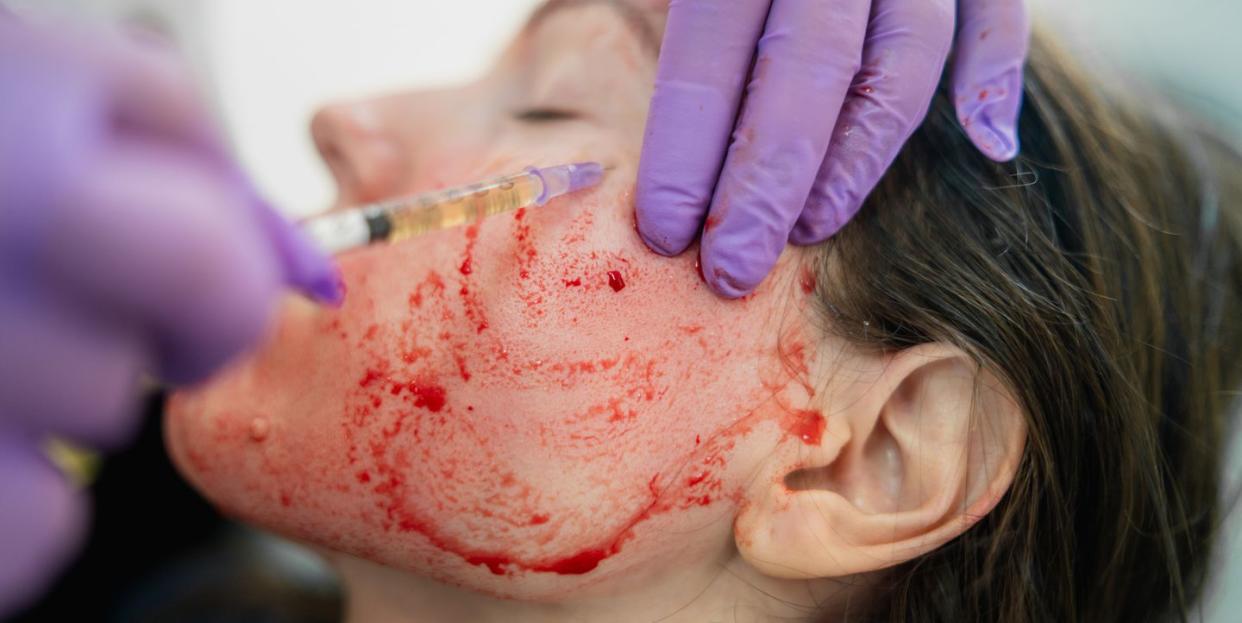WTF Is A 'Vampire Facial' And Is It Even Safe?

A spa specializing in "vampire facials" in New Mexico was shut down this week and the state's health department urged patients to undergo HIV testing.
The facial, also known as a platelet-rich plasma treatment, is used to make skin smoother and reduce the appearance of wrinkles.
Vampire facials are generally safe-as long as your practitioner uses sterile equipment in a clean environment.
When you get a facial, you generally assume that it’s a safe way to kick back and do your skin a solid. But people who recently visited a spa in New Mexico are being told to get a freaking HIV test due to possible contamination. WHAT?
The New Mexico Department of Health announced this week that that a client of VIP Spa developed an undisclosed infection that may have come from having a vampire facial treatment done at the spa. The organization is urging people who got any "injection related service, including a vampire facial," to get tested for hepatitis B and C along with HIV. (The clinic has been shut down, BTW.)
“It is very important that anyone who received a vampire facial or other injection related service at the VIP Spa in May or June of 2018 come to the Midtown Public Health Office for free and confidential lab testing and counseling,” said Lynn Gallagher, NMDOH Cabinet Secretary, in the announcement. Holy. Crap.
So…what is a vampire facial, exactly?
You may remember that way back in 2013, Kim Kardashian shared a photo of herself on Instagram with her face covered in blood, hashtagging it #VampireFacial.
Tonight on Kourtney & Kim Take Miami!!! #VampireFacial #kktm
A post shared by Kim Kardashian West (@kimkardashian) on Mar 10, 2013 at 6:14pm PDT
She and Kourtney got them done on an episode of Kourtney & Kim Take Miami, and it looked…intense. But people have been willingly subjecting themselves to vampire facials ever since.
The vampire facial (also known as a vampire facelift, a platelet-rich plasma facial, or PRP facial) involves taking a sample of your own blood, extracting the plasma (the liquid part of your blood), and then injecting it with needles back in your face, according to the American Academy of Dermatology (AAD).
Why plasma? It's rich in platelets, growth factors, and other nutrients that reportedly stimulate the growth of collagen and healthy skin cells, per the AAD.
"The jury is still out on how effective this procedure is, but many feel that it can significantly help improve skin tone, texture, and fine lines," says Joshua Zeichner, M.D., a New York City–based board-certified dermatologist and director of cosmetic and clinical research in dermatology at Mount Sinai Medical Center. Basically, the idea is that it can make your skin look plump and glowy (and younger).
"It's one of the most popular treatments at my practice," says Gary Goldenberg, M.D., assistant clinical professor of dermatology at the Icahn School of Medicine at Mount Sinai Hospital. "We use it to treat acne, acne scarring, melasma, surgical scars, and fine wrinkles and lines." (PRP can also be used on your scalp to treat hair loss because it can stimulate hair growth.)
However, results apparently take a while (like, weeks to months) to show up on your face, according to the AAD-and you might need more than one session to truly see results.
Prices vary for a vampire facial depending on where you live and where you get yours done, but don't expect it to come cheap. Goldenberg says it costs up to $1,200 (and remember, if you have to get multiple treatments, you'll be shelling that out several times.)
Should I be worried about HIV from a vampire facial?
The good news: "This is one of the safest procedures we do," Goldenberg says. Side effects include pain and bruising, according to the AAD.
The scary story from New Mexico is honestly a worst-case scenario. "When performed using proper technique and precautions, it is a safe procedure," says Zeichner. "Whenever you are performing a procedure in which there is exposure to blood, sterile technique must be used to prevent infections and avoid spreading of infectious diseases."
That said, if needles are re-used, equipment isn't being cleaned, or another patient’s blood was used for your vampire facial, you’re at risk of getting an infection.
To avoid that worst-case scenario situation, Zeichner recommends sticking with a board-certified dermatologist or plastic surgeon over a spa. That way, the vampire facial can just be a skincare treatment-and not something from your actual nightmares.
('You Might Also Like',)

